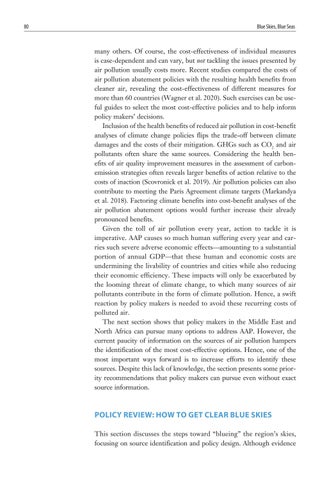80
Blue Skies, Blue Seas
many others. Of course, the cost-effectiveness of individual measures is case-dependent and can vary, but not tackling the issues presented by air pollution usually costs more. Recent studies compared the costs of air pollution abatement policies with the resulting health benefits from cleaner air, revealing the cost-effectiveness of different measures for more than 60 countries (Wagner et al. 2020). Such exercises can be useful guides to select the most cost-effective policies and to help inform policy makers’ decisions. Inclusion of the health benefits of reduced air pollution in cost-benefit analyses of climate change policies flips the trade-off between climate damages and the costs of their mitigation. GHGs such as CO2 and air pollutants often share the same sources. Considering the health benefits of air quality improvement measures in the assessment of carbonemission strategies often reveals larger benefits of action relative to the costs of inaction (Scovronick et al. 2019). Air pollution policies can also contribute to meeting the Paris Agreement climate targets (Markandya et al. 2018). Factoring climate benefits into cost-benefit analyses of the air pollution abatement options would further increase their already pronounced benefits. Given the toll of air pollution every year, action to tackle it is imperative. AAP causes so much human suffering every year and carries such severe adverse economic effects—amounting to a substantial portion of annual GDP—that these human and economic costs are undermining the livability of countries and cities while also reducing their economic efficiency. These impacts will only be exacerbated by the looming threat of climate change, to which many sources of air pollutants contribute in the form of climate pollution. Hence, a swift reaction by policy makers is needed to avoid these recurring costs of polluted air. The next section shows that policy makers in the Middle East and North Africa can pursue many options to address AAP. However, the current paucity of information on the sources of air pollution hampers the identification of the most cost-effective options. Hence, one of the most important ways forward is to increase efforts to identify these sources. Despite this lack of knowledge, the section presents some priority recommendations that policy makers can pursue even without exact source information.
POLICY REVIEW: HOW TO GET CLEAR BLUE SKIES This section discusses the steps toward “blueing” the region’s skies, focusing on source identification and policy design. Although evidence






